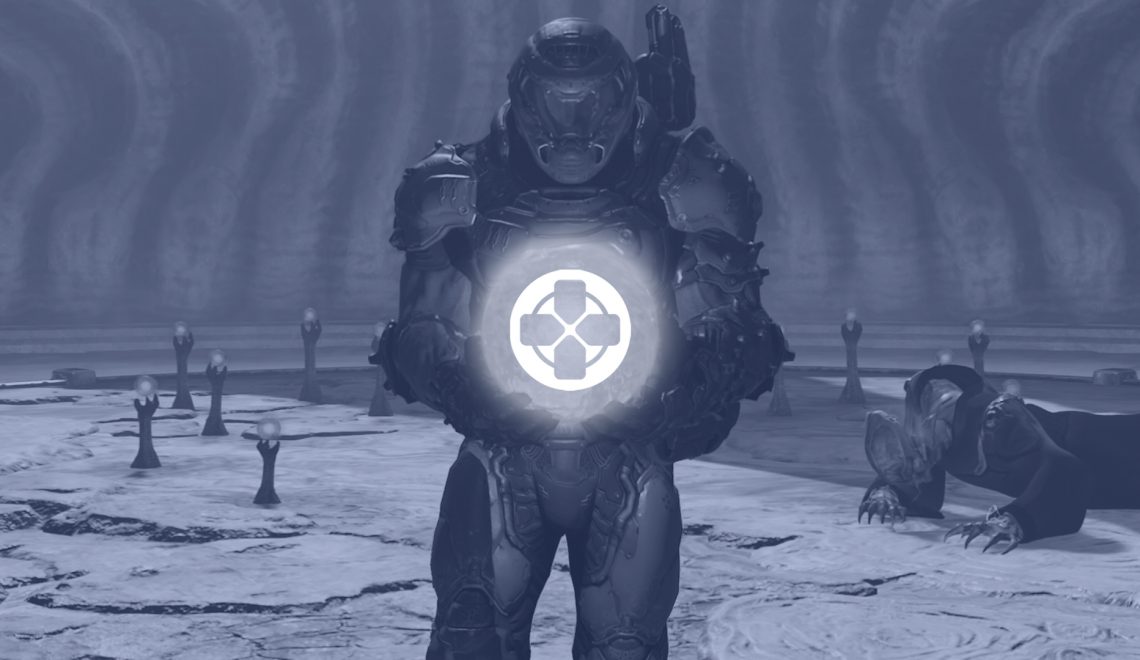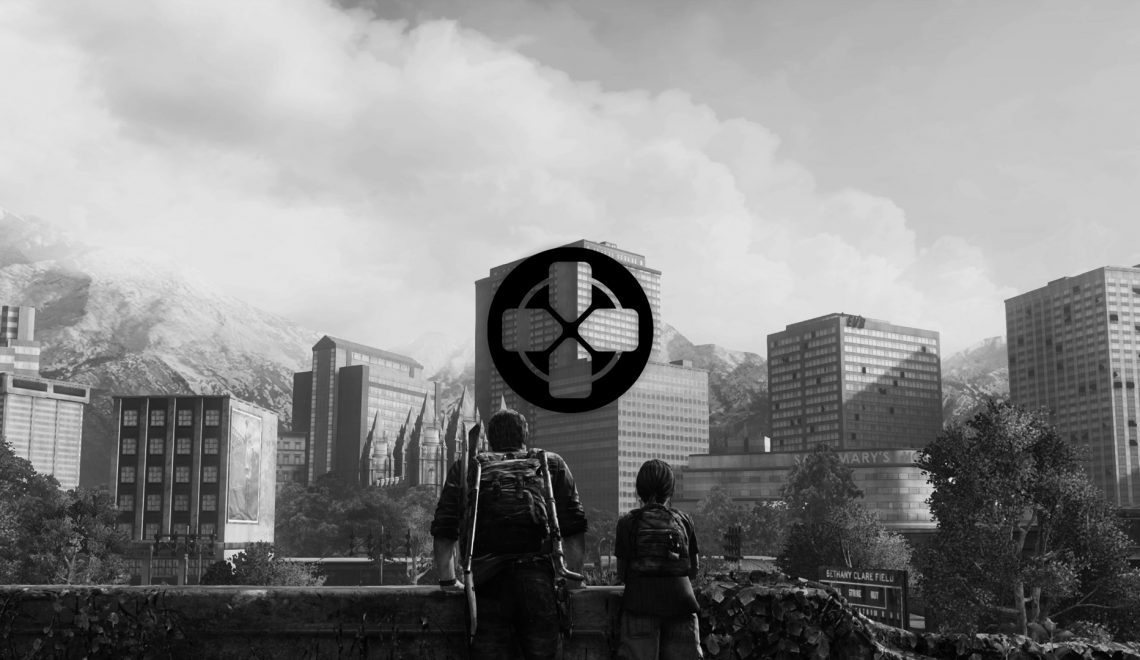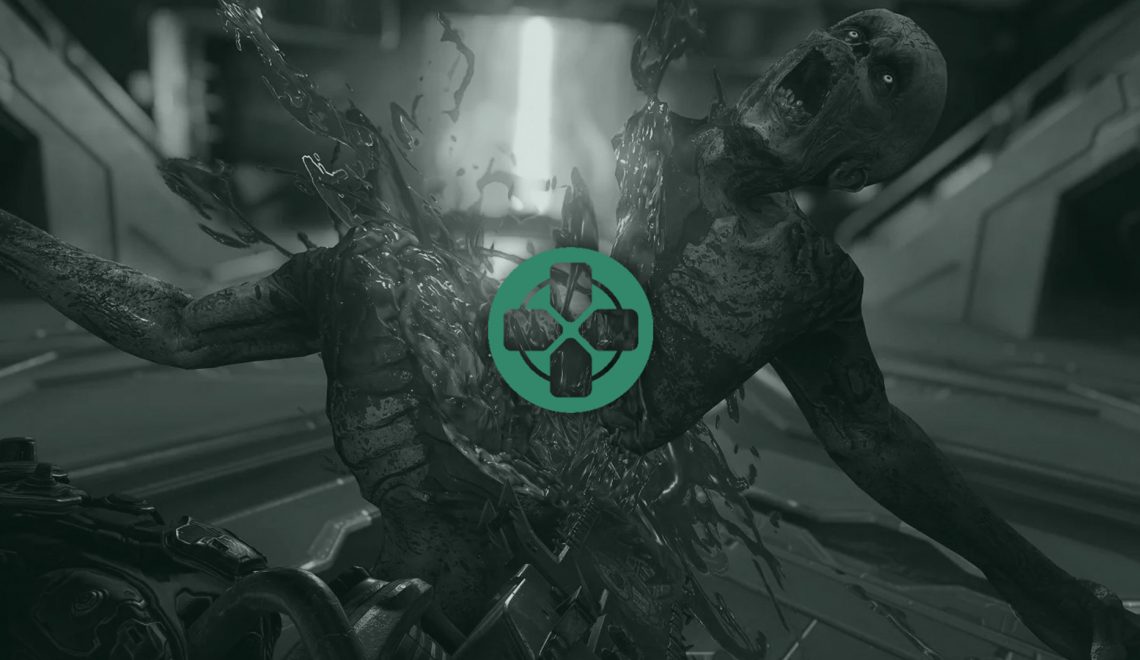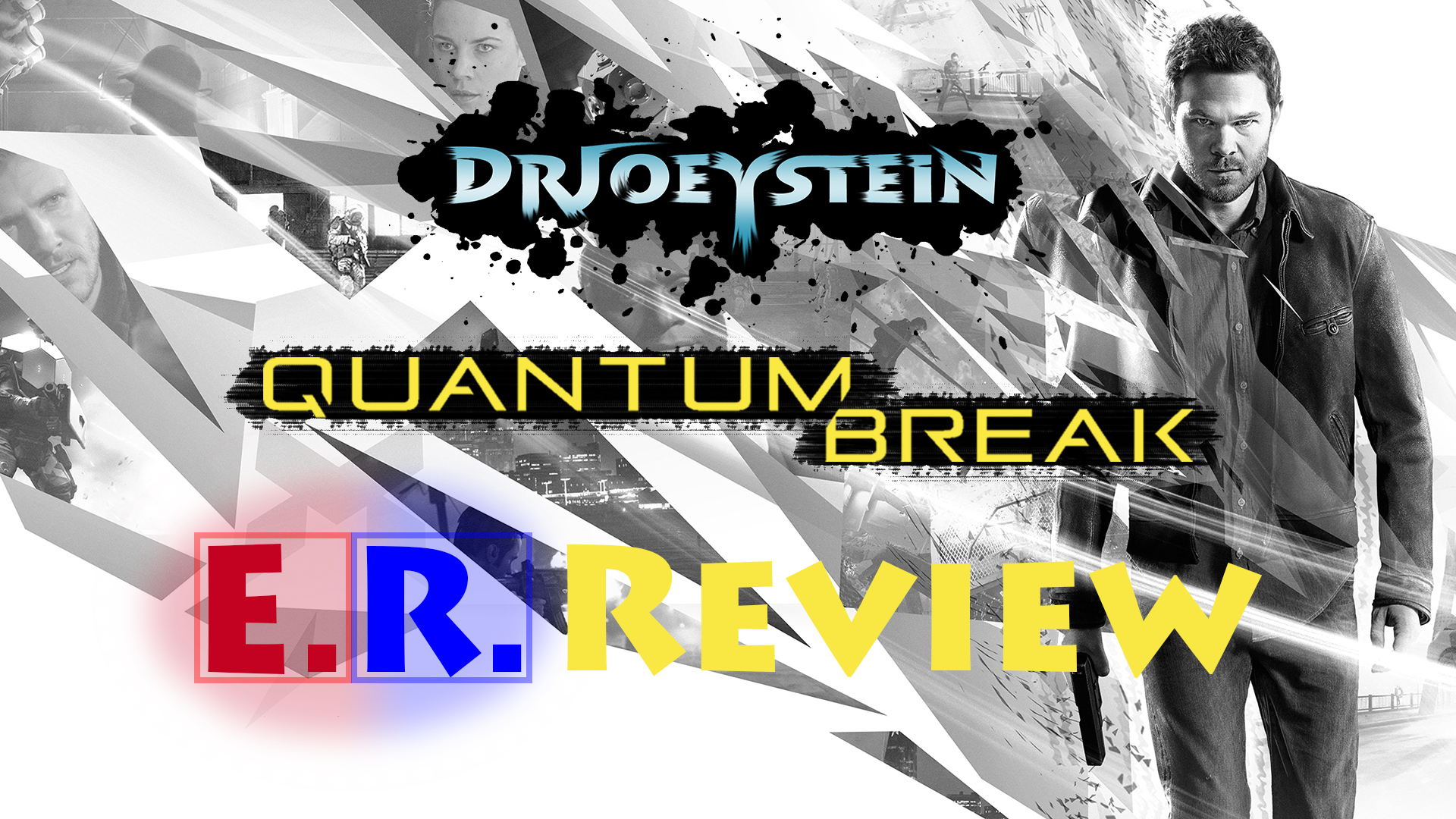
Remedy Entertainment is known for taking its time with video game development, and Quantum Break is not an exception in breaking this reputation. Having released the wonderfully bizarre Alan Wake in 2010, the Xbox One exclusive (well, sort of) has a lot to live up to, particularly in the storytelling department. Since there’s a high-budget TV show produced around the game that’s interwoven and influenced by in-game decisions, it’s a sure indicator that this Finnish developer has potentially realized a long-held dream to instigate a greater marriage between film and video games. This ambitious goal set with Quantum Break has made the wait seem reasonable enough, so has the Xbox One received its overdue, must-have system seller? Or should it fall victim to the annals of time due to superficial elements that hide deeper problems?
Stutterer
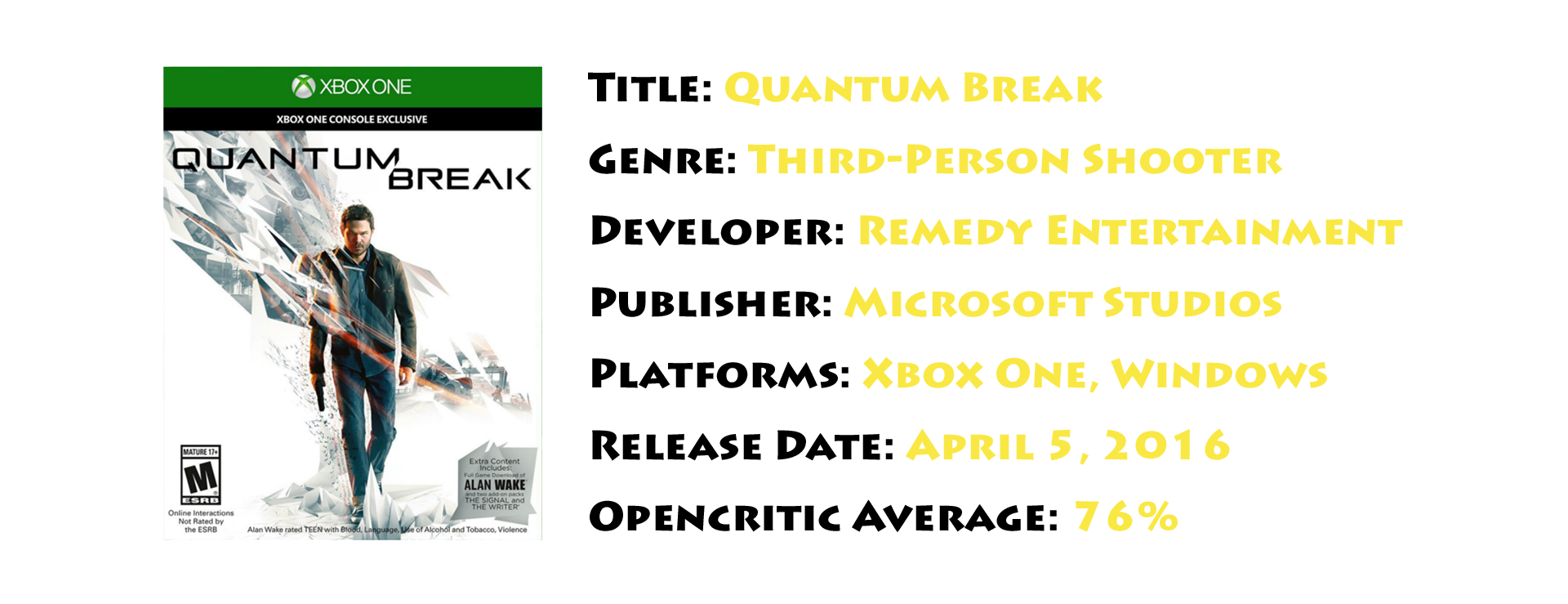
YouTube Version of the Review at the End
Jack Joyce is a carefree soul who thrives on his independence. Having suffered the loss of his parents at a young age, he was put in the care of his brother, William, who happens to be 10 years his elder. Despite the age discrepancy, William’s inept social skills and busy mind distanced him from Jack, who found joy elsewhere in like-minded friends such as Paul Serene and the excitement of traveling abroad. Without parental guidance, he also got involved with petty illegal activities on local and international levels, and this mischievousness follows him with the game’s opening. Paul invites Jack to come back to his hometown of Riverport to test a time machine he helped construct alongside William, even though this was against his wishes since he believed the device has errors in its design that must be resolved. Before Paul is able to walk through the machine with Jack observing from the outside, William tries to stop them both at gunpoint from going any further, but he’s too late as it malfunctions, sending out an explosion of time energy. Paul disappears and Jack is knocked unconscious from the blast.
Jack wakes to discover he can manipulate Chronon particles (time energy) to freeze, slow down, or speed up time in differing ways, which proves useful when a corporation called Monarch Solutions shows up with a private military to kill him and William. What makes its sudden appearance all the more surprising is that it’s led by none other than a much older, more draconian version of Paul Serene. How? What happened to him? What’s going on with time itself? Can it be fixed? Be prepared for a wibbly-wobbly, timey-wimey mess as Jack fights against Paul and his goons with old and new friends in a bid to save the world from the end of time itself.

Paul Serene is my favorite character from the game. Conflicted yet determined and cold yet human, he’s a well-written villain with believable motives.
Time travel is an overdone narrative subject, but Quantum Break has cool contributions to make with its impressively complex grasp on time travel logic. Throughout the first half of the game, you’ll be confused by what some characters will say and events that occur, but as time passes you’ll receive revelations about them that will make you exclaim, “So that’s what happened all along!” The past and future are in a constant battle with the characters and their objectives to influence them, so you’re getting the bigger picture as you play. This gives more context and depth to previous plot points that will have you respecting the writers’ consistent understanding of their own material, even if paradoxes (not necessarily bad ones, mind you) are allowed such as causal loops.
The characters are fairly compelling as well. Jack is a particularly one-note character who rides the tides of his emotions, but I really appreciate how Paul is portrayed as a suave villain with worthy motivations that back all of his cold, calculating decisions in the name of the greater good. Side characters like Beth Wilder and William are fine characters in their own rights, but their personalities are outshone by their time traveling mishaps and adventures, which is what primarily makes them interesting to pay attention to because of their awesome backstories. Other side characters such as Martin Hatch, Charlie Wincott, Fiona Miller, and Liam Burke take on lead roles in the TV show that plays between the game’s Acts. There are a few standout performances, but the likes of Charlie and Fiona mostly suffer from characterization I didn’t take a liking to. Most of them also felt inconsequential to learn about, having minor, poorly implemented connections to the in-game story.
Speaking of the TV show, it has some honestly impressive set pieces and special effects. While I didn’t really take to most of the characters themselves, I love the scenes involving Paul and his corporation. It gave me a good grasp of how Monarch is run from the top, what it’s like from the perspectives of those who work within it, and how everyone was responding to Jack’s doings. The most unique aspect of the show is that episodes have different outcomes depending on minor actions you take as Jack throughout the game. However, the main contributor to this change involves Junction Impacts. They’re small sections where you play as Paul and are put in situations where you decide between two courses of action that will lead to personalized versions of the future. I don’t like how they literally show you most of what will happen and how simple they are, but I definitely appreciated how your decisions ripple across both the game and show in drastic ways. It only made me want to play as Paul more with actual combat sections instead of only these short narrative breaks.
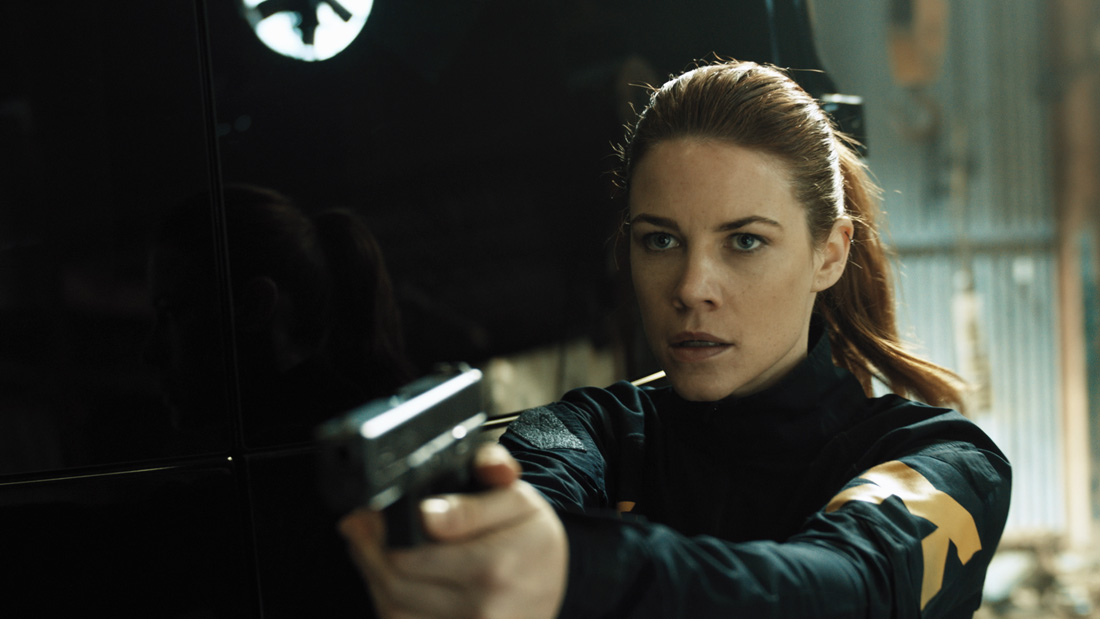
I’d say Beth Wilder is the biggest mystery and most interesting character in the game. I didn’t find her appealing as a character, but her backstory is tragic and fascinating.
The story may not pack quite the same punch as Alan Wake‘s did with its out-of-the-box originality and more compelling mysteries, but it’s still a solid tale with a fairly well-rounded cast that secures much of its intrigue with time travel nonsense that, well, tries to make a lot of good sense. As a side note, one thing that struck me about its message is that we cannot change the past, which runs antithetical to most time travel movies’ plot points. There’s a running cynicism and insurmountable helplessness many of the characters go through because of this focus, which seems to teach that we should accept the past for what it is and try to change the future instead. It’s an unexpected message that’s delivered well for a time travel story like this.
I mentioned that Jack has obtained time-altering abilities from his exposure to Chronon particles, and these attempt to make the third-person shooter gameplay stand out. However, the results are a hit-and-miss with some great mechanics and ideas surrounded by mediocre enemy encounters and design gripes. Starting with the core gameplay, the shooting mechanics are fine. A lot of the guns lack a sense of weight compared to Alan Wake’s weaponry, but at least there’s over twice to experiment with and pick up. Most of the time you’re either moving from cover to cover or craftily stringing together your time powers in the open. The former is actually guided by an entirely contextual system where you never have to press a button to crouch, and while it gets a bit wonky on occasion, most of it is impressively done that doesn’t present problems when you need to back off from foes. When it’s time to go hard, you’ve got several tricks up your sleeve like Time Shield, which briefly absorbs all damage that comes your way while allowing you to shoot freely from inside. Others like Time Dodge and Time Run respectively allow you to do a dash that essentially teleports you a short distance or slow down time to rush someone and perform a devastating melee attack. Two of my favorites are Time Stop and Time Blast, which you, again, respectively use by tapping RB to freeze an opponent in a bubble that absorbs all of your bullets or holding that button to unleash a devastating explosion.
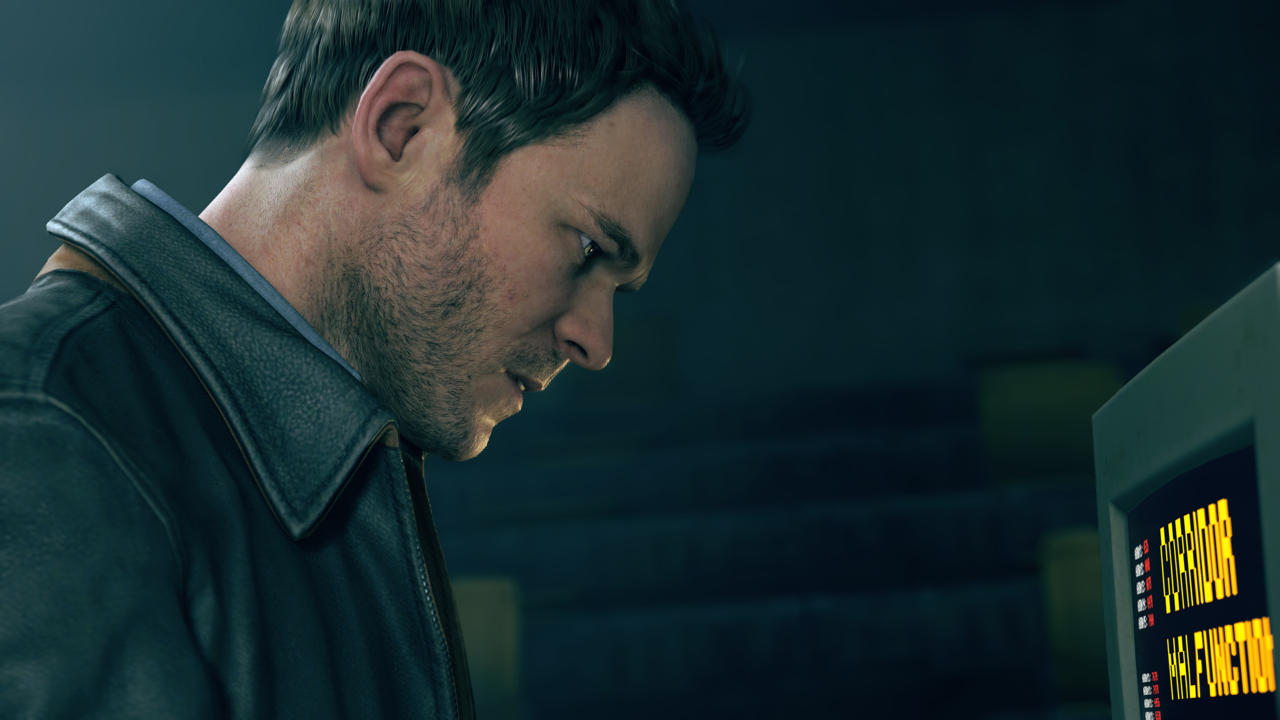
Jack has an amiable personality, but is ready to become a killing machine to fight for his friends and beliefs. His combat efficiency is also shocking, which makes me wonder what he did during his international travels…
The game shines brightest and is most rewarding when you’re able to string these moves together and take out a group of bad guys within moments, but for some reason, attempting to do this feels a bit clunky, not to mention slowly tiring as the hours go by. The reason behind this is that even on the hardest difficulty, dealing with the AI isn’t that bad since they’re not very aggressive or taxing. A generous amount of health makes dealing with them even more easy with the exception of a few difficulty spikes. Whenever those happen though, it’s not that the AI gets smart, but that the game throws out a bunch of bullet sponges that can prove to be irritating, since you might find yourself at a standstill with no ammo. You would think melee attacks would be a good backup plan, but they’re only possible with the Time Run ability that has limited uses. It’s a standard mechanic that’s bewilderingly absent here since Jack seems perfectly capable of using the butt of a gun, but nope.
There are missed opportunities to expand on the way time powers could’ve been used, how enemies should work together, and how environments could’ve included more options to take out foes with creative methods. For example, several of the time powers and weapons encourage CQC, so a combo-based melee system/time powers could’ve increased the immersion of fights in this manner. Heck, wouldn’t it have been fun to have a brief slow-mo period after performing a tough melee combo where you can shoot distant foes with ease? Unfortunately, in the actual game you’re left awkwardly out in the open once you take down one enemy or two with this close type of approach. The abilities are fun while they last, but they mask the game’s lacking approach to the very ideas it could’ve done with the gameplay.
Enemy groups have little varying types, and therefore don’t take advantage of compromising your position by coordinating their efforts. Most of the AI would stay back or slowly approach me, leaving plenty of time to take potshots with my gun or time powers to overcome them. Part of the straightforward AI’s unchallenging intelligence is the flat, undynamic level design that pervades action settings. While the environments are realistically convincing with their layouts, they don’t enhance the gameplay that well. This is also evident with the awkward platforming between encounters that have you getting past “Stutters” (areas where time is broken) with your abilities since objects around you act erratically to impede your progress, such as automatic doors that are sped up to dangerous speeds that you need to slow down and dash through to keep on going. You can also rewind time on specific objects to access new locations by rebuilding a stack of boxes or reorienting a row of shelves that block your way. I would’ve preferred if more combat environments had been designed with opportunities to do this so you could alter objects for tactical advantages by, say, reconstructing a path to access a tower you can snipe from or making scaffolding collapse on some bad guys. But this isn’t the case, which points to the game’s underwhelming implementation of promising concepts.
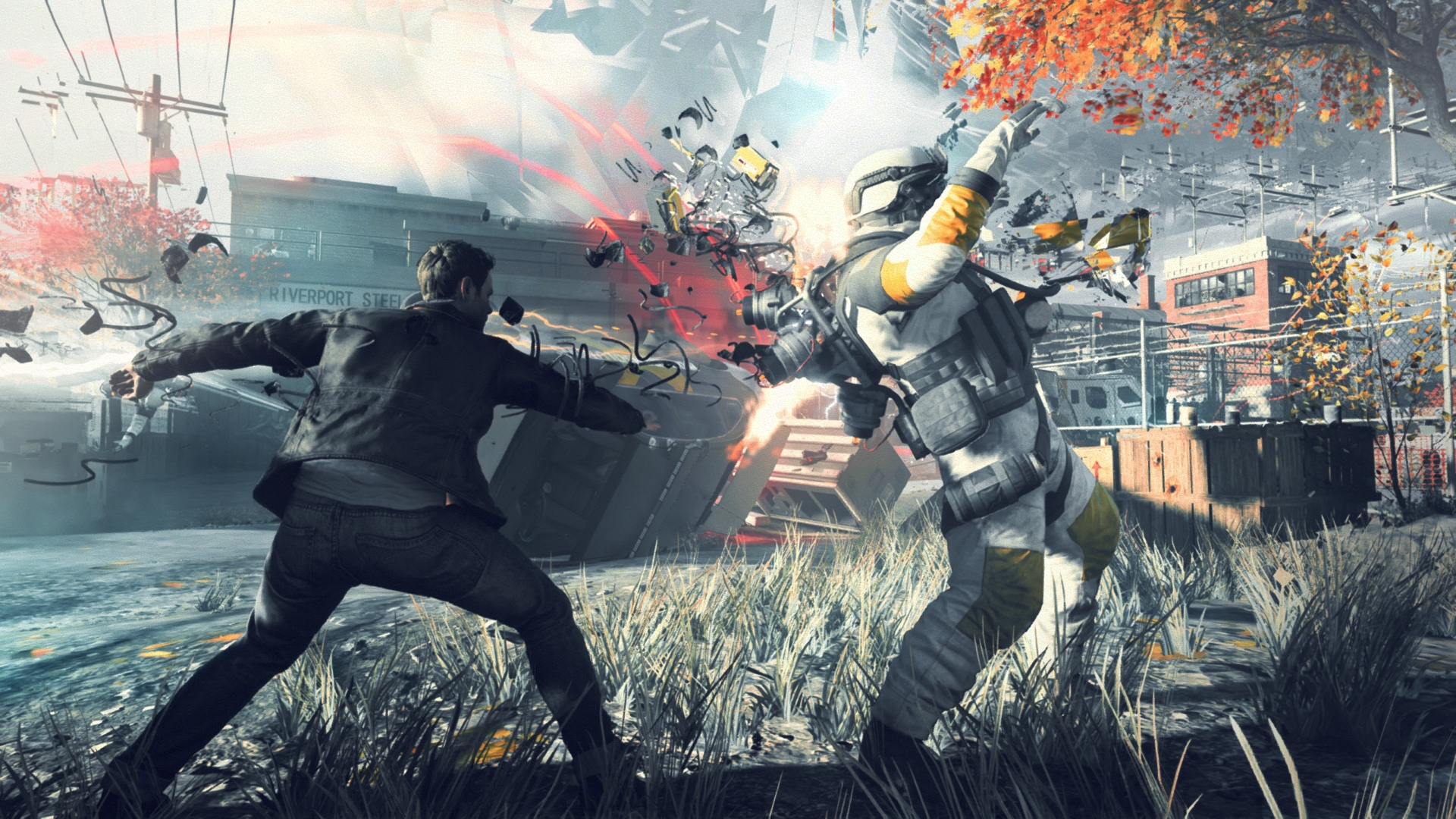
Enemies like Strikers are really cool, as depicted here. They aren’t affected by Stutters due to the device on their backs, and can dash forward in time just like you. However, disabling their packs or killing them will render them statues frozen in time. Just wish they were smarter and had more surprises up their sleeves.
You can upgrade powers by finding Chronon sources, and while these are helpful to prolong some of their effectiveness and damage, this system doesn’t build upon powers with meaningful twists that challenge you to use them in new, exciting ways. Other than this, the interim between fights is not only occupied by the stilted platforming, but also narrative collectables to find and character interactions to engage in. While the latter is worth your time, you’ll groan at how lengthy the extraneous story details are to read. I paid attention to them at first since they provide nice context to some characters’ histories and relationships with one another, but it got to the point where there were so many of them that they destroyed the game’s flow since I would end up taking 20 minutes to read several emails, journal entries, and so forth in a single room. Alan Wake didn’t suffer from this issue because it respected the player’s time with mercifully shorter things to pick up and read.
I will say the game does have some levels with jaw-dropping scenes, visual effects, and cutscenes. The motion capture and detail with faces comes close to rivaling Uncharted 4: A Thief’s End, but what Quantum Break has that no other game can boast are those Stutters. To elaborate, they are a result of time breaking down due to the time machine explosion at the story’s beginning. While normal people can’t tell this is happening, Jack is able to operate outside these Stutters to see moments where time freezes and causes reality to go berserk. Some things remain frozen, but a moving car or falling piece of debris will zoom back and forth during a Stutter at varying speeds, which will cause it to turn up somewhere else when time resumes. In other words, time being messed up results in everything being out of sync, which creates these beautiful sceneries of chaos that Jack has to carefully navigate through due to how Stutters unpredictably alter objects’ motions. Only a screenshot can do justice to what I’m describing!
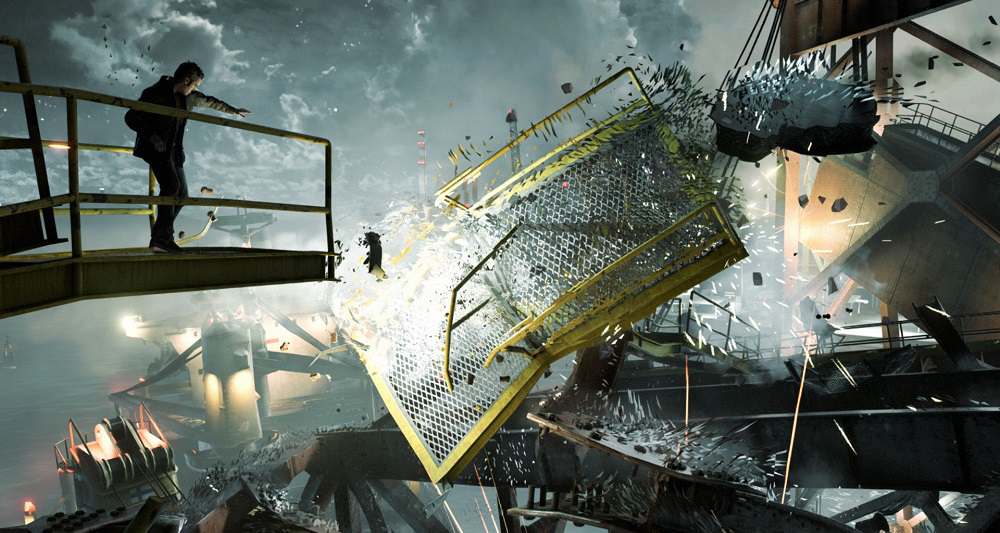
This is pulled from an older trailer for the game, but accurately captures one of the level’s awesome Stutter scenes.
I also love the glassy, fractured look that time powers impose on things whenever you use them, which light up the environment with bright colors and leave ripples of energy once they dissipate. If there’s any place Quantum Break should be highly commended, it’s how this complex, utterly unique visual flair was crafted by Remedy. Unfortunately, the Xbox One version suffers from graphical issues and limitations. Poor shadows, blurry effects, and 720p resolution reveal the console’s notable restrictions, and one thing I couldn’t stand is that characters have this excessive blur that leaves jarring echoes of motion. Imagine you turn on your mouse pointer’s trail and apply that to the game. That’s exactly what you’ll see with the in-game models. Yes, their animation and facial expressions are surprisingly detailed, but that problem clashes with these achievements, which speaks for the game’s graphics on a large scale. There are some stunning scenes that will make you gasp in amazement, but these treats are offset by hardware limitations and filmic effects that encase Quantum Break behind a veneer of flaws.
I’ve mentioned how guns feel weak to handle, and half of this is contributed to the oddly brittle audio used for gunshots. With that out of the way, I can say that the rest of the sound effects are thorough with specific attention put toward how time would sound if you could play around with it. Excessive bass, glass crackling, stressed electricity…these are some ways in which I’d describe the way “time” sounds, and I love how normal sound effects are extended, skipped, echoed, and distorted when affected by Stutters or Jack’s powers. Petri Alanko empowers this eccentric soundscape with his subdued, heavy, electronic tracks with high tempos, synthesizers, and weird effects like static mixed in with piano and electronic guitars. It reminds me of Daft Punk’s TRON soundtrack and Solar Field’s work on the Mirror’s Edge franchise, and even though I don’t find it as emotionally affecting as his previous work on Alan Wake, saying it isn’t impressive or experimental would be disingenuous. I should add that all of the actors and actresses – whether in-game or in the TV show – suit their respective roles well. I may have not gravitated toward some of the characters in themselves, but all of their performances are great for whomever they individually aim to portray.
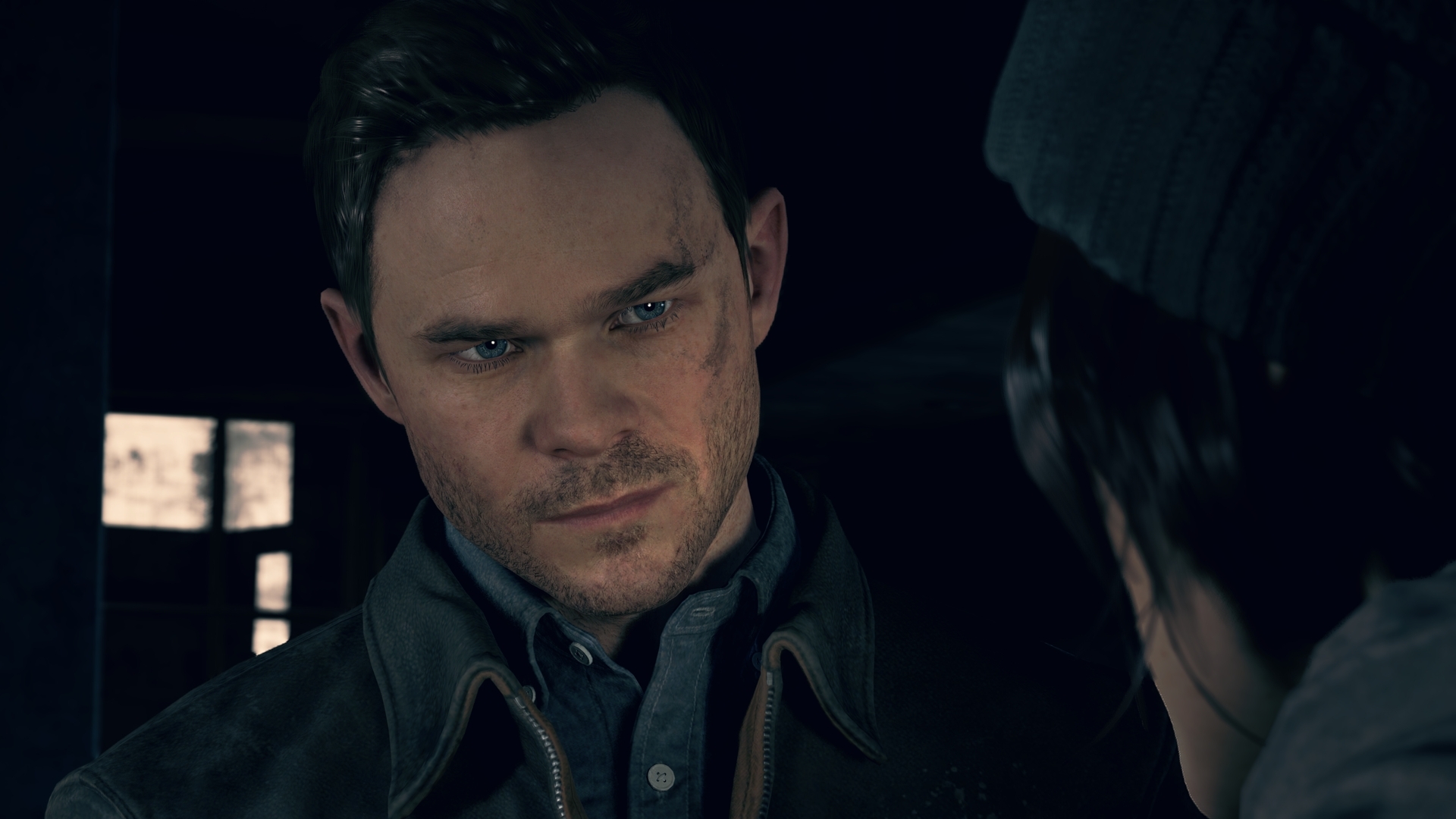
This is from a cutscene. Yes, the detail on Jack’s face is unreal. Fantastic work on Remedy’s part by capturing the actors’ likenesses to perfection.
The campaign will suck up about 10 hours of your time, which is an acceptable length for the story it has to tell. Each of the four episodes in between the game’s acts is over 20 minutes, which all serve as appropriate breaks. As for replay value and extra content, I think there’s some motivation to go through it all again if you’re invested in the story. As I said before, there are a boatload of events that only make sense as you play the game, so going back to experience them all with a new perspective allows you to appreciate the depth of how they all string together. You can also take more time to read those excessively long narrative items, but other than that, I really don’t see a reason for most people to experience the game again unless they want to see how making different decisions at Junction Points will alter the live-action episodes.
Conclusion
I love video games that push the medium forward by employing risky directions or exploring uncharted territory. It does pay off on occasion, but even when it doesn’t, I always respect developers who are daring enough to do this. Quantum Break seemed like it wanted to do this by bridging film and video games together in a profound way, but we’re left with a game that not only feels a few years out of time, but also one that doesn’t push the storytelling capabilities of its medium. The game does boast high production values with its show and captivating graphical effects, which are aided by a thoughtful story that tackles time travel with a logical, thematic bend. However, most of this obscures half of the boring characters and the show’s focus on mostly uninteresting side characters. The audio may be great all around, but the fascinating visuals and gameplay are marred by unfortunate limitations, respectively from a technical and imaginative standpoint. Remedy’s passion and distinct projects are to be admired, and Quantum Break is a partial demonstration of this with the ambitious connection it has with its own show. But the studio needs to step up its game and get with the times if it hopes to push back to the future with real substance to its content.
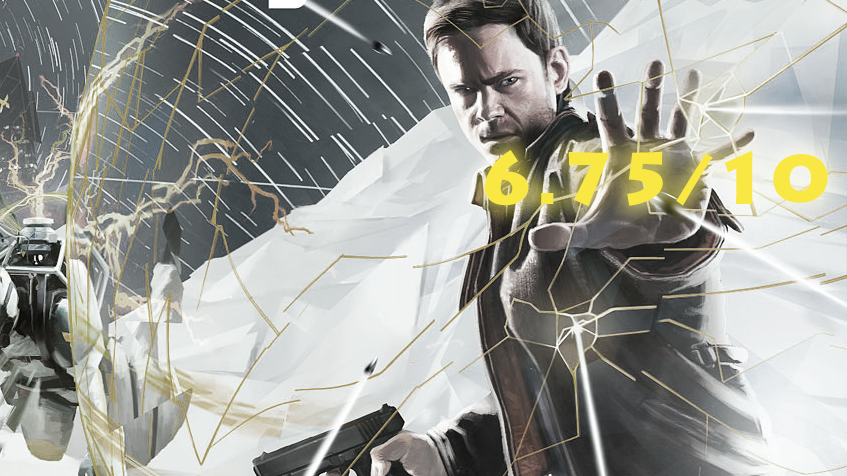
Edit: Corrected Alan Wake release date from 2008 to 2010.

